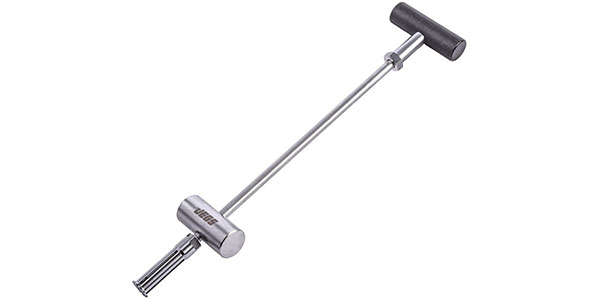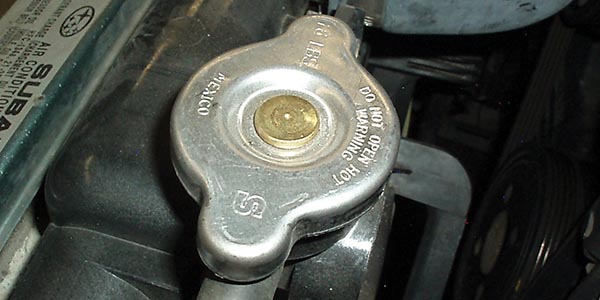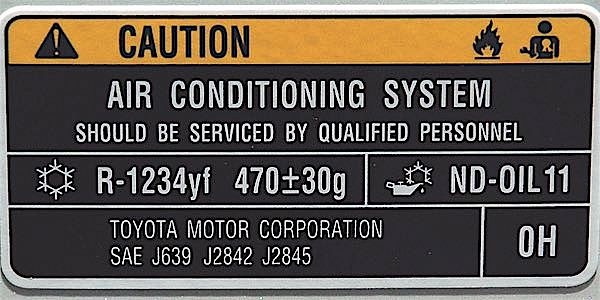Although the mechanics of modern master cylinders seem deceptively simple, today’s dual-piston or tandem master cylinders still require the utmost in care and attention to maintain safe, reliable operation. The tandem master cylinder contains two piston assemblies; one for each axle set or diagonally located pair of brakes. Each piston assembly has two lip seals mounted in grooves on the pistons. The rearmost piston cup or lip seal holds the fluid in the master cylinder and against the back of the forward cup. The forward cup applies hydraulic pressure to the braking system as the brake pedal is depressed.
A return spring, which is contained in the front of the master cylinder bore, returns the piston assembly to a rest position after the driver releases pressure on the brake pedal. As the piston returns to the rest position, brake fluid flows around the lip of the forward seal to replenish fluid in the master cylinder bore. In all drum-brake, single cylinder designs, the return spring holds a residual check valve in place to retain a few pounds per square inch of pressure in the hydraulic system.
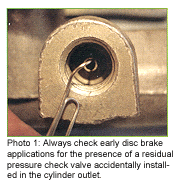 Depending upon the application, tandem dual master cylinders may incorporate a residual check valve in one or both outlet ports located on the side of the cylinder (see Photo 1). Residual pressure prevents air from migrating into the brake hydraulics and preloads a drum brake’s wheel cylinder linkage. Because of improved design, many later-model drum applications eliminated the residual check valve altogether.
Depending upon the application, tandem dual master cylinders may incorporate a residual check valve in one or both outlet ports located on the side of the cylinder (see Photo 1). Residual pressure prevents air from migrating into the brake hydraulics and preloads a drum brake’s wheel cylinder linkage. Because of improved design, many later-model drum applications eliminated the residual check valve altogether.
Looking into the reservoir, each of the tandem cylinders has a “breather” port that allows the piston to draw fluid into the cylinder behind the forward cup. The compensation port, which is located forward of the breather port, allows fluid pressure to bleed out of the cylinder bore when the brake pedal is released. The compensation port also allows air to bleed from the cylinder into the master cylinder reservoir as the pedal is depressed.
The most important point to remember during any master cylinder diagnosis is that an inch of travel at the brake pedal translates into only a few thousandths of an inch of piston travel at a disc brake caliper or brake cylinder. Consequently, the fluid displacement of a master cylinder is matched very closely to the fluid volume requirements of the brake system itself.
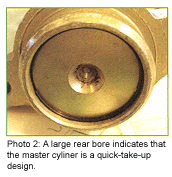 Obviously, the clearance between a brake pad and rotor may drastically affect master cylinder operation. Some caliper applications use a square-cut piston seal to retract the piston a few thousandths of an inch when the brakes are released. Some caliper applications may require a “quick-take-up” cylinder (see Photo 2) to close these relatively large pad-to-rotor clearances as the brake pedal is applied.
Obviously, the clearance between a brake pad and rotor may drastically affect master cylinder operation. Some caliper applications use a square-cut piston seal to retract the piston a few thousandths of an inch when the brakes are released. Some caliper applications may require a “quick-take-up” cylinder (see Photo 2) to close these relatively large pad-to-rotor clearances as the brake pedal is applied.
FAILURE PATTERNS
Most master cylinder failures are caused by leaks developing around the piston seals. As the piston seals wear or the cylinder bore becomes scuffed or pitted, piston seal leaks cause a falling or spongy feel in the brake pedal. The falling pedal symptom is caused by fluid leaking from the brake hydraulic system into the atmosphere or by fluid leaking internally around the piston seals.
A spongy brake pedal can occasionally be attributed to a master cylinder with a worn rear seal. In these cases, air enters the cylinder as the pedal is released and is sometimes pumped into the hydraulic system. Because air compresses, the most noticeable symptom is a spongy brake pedal. Theoretically, the ingested air should harmlessly bleed through the breather or compensation ports into the master cylinder reservoir. In reality, when combined with system failures that cause excess pedal travel, the ingested air can migrate into the main hydraulic system. A master cylinder mounted at an upward angle is also very conducive to allowing ingested air to migrate into the brake hydraulics.
A worn rear seal will also allow brake fluid to mysteriously disappear from the master cylinder reservoir into the vacuum brake booster and ultimately into the engine intake itself. One indicator of this condition, of course, is fluid consumption without evidence of external leakage. Another indicator is a wet area forming around the mounting flanges of the master cylinder.
Last, a master cylinder most often fails during the brake bleeding process because the cylinder ingests dirt, rust or sludge from the reservoir while the system is being bled by pumping the brake pedal. In most cases, the best procedure is to bleed the master cylinder with a pressure or vacuum-bleeding tool. If the reservoir is heavily contaminated, the cylinder should be replaced because of the possibility of debris entering the cylinder and interfering with seal contact.
FLUID INSPECTION
Before testing any master cylinder, always remove the master cylinder reservoir cap and inspect the fluid level and color, and the viscosity of the brake fluid. A low fluid level may indicate worn brake pads or a leak in the brake hydraulic system. Discolored fluid indicates excessive contamination of the fluid from moisture or foreign materials. A very viscous fluid may indicate that the fluid level has been topped off with lubricating oil, which usually causes the rubber seal on the reservoir cap to swell out of place. If the fluid has been contaminated with oil, all of the rubber parts in the brake system must be replaced in order to restore maximum reliability and safety.
Rusty fluid, quite naturally, indicates that the entire system has suffered extensive internal corrosion and should, therefore, be considered unsafe for further use. If the fluid is blackened or sludged from normal wear, the system may need flushing. In cases of severe sludging, the master cylinder should be replaced to prevent sludge particles from interfering with seal contact on the cylinder bore.
DIAGNOSTICS
Brake pedal feel is often vehicle-specific because some vehicles allow for a longer length of brake pedal travel than others. In general, a good master cylinder should provide a positive, controlled sense of braking. A falling, spongy or low pedal, on the other hand, indicates a problem with the master cylinder or the brake system hydraulics.
In general, a good master cylinder should allow the driver to “pump” the brake pedal to build pressure in the brake hydraulics. Several quick applications of the brake pedal should be enough to bring the pedal to normal operating height and establish a firm brake pedal. If pedal height characteristics can’t be achieved by pumping the pedal, the master cylinder is defective or air is trapped in the hydraulic system.
As opposed to pumping the brake pedal, gradual application allows the lip seals to function in a relaxed position. Consequently, a worn master cylinder might be detected by gradually applying pressure to the brake pedal with the engine running to provide assist. If the lip seals in the cylinder are excessively worn, the pedal may sink completely to the floor during a gradual application.
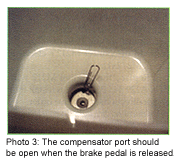 Occasionally, a newly installed master cylinder will fail to release pressure from the brake hydraulic system and cause the brakes to either lock up or drag. In these cases, the forward lip seal has failed to retract past the compensator port due to a faulty adjustment on the brake booster push rod, or a bad adjustment of the brake light or cruise control vacuum break switch on the brake pedal lever. A quick way to test for piston retraction is to gently probe through the compensating port with the blunt end of a paperclip (see Photo 3). If the cylinder has an open-top reservoir, depressing the brake pedal should cause fluid to spurt from a momentarily open compensator port. Some master cylinders are very aggressive in this regard, so it’s best to hold a shop rag over the reservoir to absorb the ejected brake fluid!
Occasionally, a newly installed master cylinder will fail to release pressure from the brake hydraulic system and cause the brakes to either lock up or drag. In these cases, the forward lip seal has failed to retract past the compensator port due to a faulty adjustment on the brake booster push rod, or a bad adjustment of the brake light or cruise control vacuum break switch on the brake pedal lever. A quick way to test for piston retraction is to gently probe through the compensating port with the blunt end of a paperclip (see Photo 3). If the cylinder has an open-top reservoir, depressing the brake pedal should cause fluid to spurt from a momentarily open compensator port. Some master cylinders are very aggressive in this regard, so it’s best to hold a shop rag over the reservoir to absorb the ejected brake fluid!
While there are no set rules for replacing master cylinders as a preventive maintenance, replacing an otherwise serviceable master cylinder might be recommended when the brake fluid is heavily sludged or when the vehicle has accumulated very high mileage. After all, safety and reliability is the primary consideration in recommending any brake service, including master cylinder replacement.











